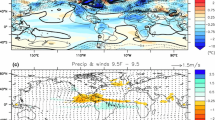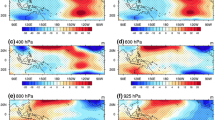Abstract
Variations of the volume of warm water above the thermocline in the equatorial Pacific are a good predictor of ENSO (El Niño/Southern Oscillation) and are thought to be critical for its preconditioning and development. In this study, the Warm Water Volume (WWV) interannual variability is analysed using forced general circulation model experiments and an original method for diagnosing processes responsible for WWV variations. The meridional recharge/discharge to higher latitudes drives 60% of the ENSO-related equatorial WWV variations, while diabatic processes in the eastern equatorial Pacific account for the remaining 40%. Interior meridional transport is partially compensated by western boundary transports, especially in the southern hemisphere. Diabatic equatorial WWV formation (depletions) during La Niña (El Niño) are explained by enhanced (reduced) diathermal transport through enhanced (reduced) vertical mixing and penetrating solar forcing at the 20°C isotherm depth. The respective contribution of diabatic and adiabatic processes during build-ups/depletions strongly varies from event-to-event. The WWV build-up during neutral ENSO phases (e.g. 1980–1982) is almost entirely controlled by meridional recharge, providing a text-book example for the recharge/discharge oscillator’s theory. On the other hand, diabatic processes are particularly active during the strongest La Niña events (1984, 1988, 1999), contributing to more than 70% of the WWV build-up, with heating by penetrative solar fluxes explaining as much as 30% of the total build-up due to a very shallow thermocline in the eastern Pacific. This study does not invalidate the recharge/discharge oscillator theory but rather emphasizes the importance of equatorial diabatic processes and western boundary transports in controlling WWV changes.













Similar content being viewed by others
References
Alory G, Delcroix T (2002) Interannual sea level changes and associated mass transports in the tropical Pacific from TOPEX/Poseidon data and linear model results (1964–1999). J Geophys Res 107. doi:10.1029/2001JC001067
Barnier B et al (2006) Impact of partial steps and momentum advection schemes in a global ocean circulation model at eddy-admitting resolution. Ocean Dyn 56:543–567. doi:10.1007/s10236-009-0180-y
Bentamy A, Grimas N, Quilfen Y (1999) Validation of the gridded weekly and monthly wind fields calculated from ERS-1 scatterometer wind observations. Global Atmos Ocean Syst 6:373–396
Blanke B, Delecluse P (1993) Variability of the tropical Atlantic ocean simulated by a general circulation model with two different mixed layer physics. J Phys Oceanogr 23:1363–1388
Bosc C, Delcroix T (2008) Observed equatorial Rossby waves and ENSO-related warm water volume changes in the equatorial Pacific Ocean. J Geophys Res-Oceans 113(C06003). doi:10.1029/2007JC004613
Brodeau L, Barnier B, Penduff T, Treguier AM, Gulev S (2010) An ERA-40 based atmospheric forcing for global ocean circulation models. Ocean Model 31:88–104. doi:10.1016/j.ocemod.2009.10.005
Brown J, Fedorov A (2010) Estimating the diapycnal transport contribution to warm water volume variations in the tropical Pacific ocean. J Clim 23:221–237. doi:10.1175/2009JCLI2347.1
Cane M, Zebiak SE (1985) A theory for El Niño and the southern oscillation. Science 228:1084–1087
Clarke AJ, Van Gorder S, Colantuono G (2007) Wind stress Curl and ENSO discharge/recharge in the equatorial Pacific. J Phys Oceanogr 37:1077–1091
Collins M, An S-I, Cai W, Ganachaud A, Guilyardi E, Jin F-F, Jochum M, Lengaigne M, Power S, Timmermann A, Vecchi G, Wittenberg A (2010) The impact of global warming on the tropical Pacific and El Niño. Nat Geosci 3:391–397. doi:10.1038/ngeo868
Cravatte S, Madec G, Izumo T, Menkes C, Bozec A (2008) Progress in the 3-D circulation of the eastern equatorial Pacific in a climate ocean model. Ocean Model 17:28–48. doi:10.1016/j.ocemod.2006.11.003
Delcroix T (1998) Observed surface oceanic and atmospheric variability in the tropical Pacific at seasonal and ENSO time scales: a tentative overview. J Geophys Res 103:18611–18633
Fichefet T, Maqueda MM (1997) Sensitivity of a global sea ice model to the treatment of ice thermo-dynamics and dynamics. J Geophys Res 102:609–646
Ganachaud A et al (2008) Southwest Pacific ocean circulation and climate experiment. Part II. Implementation plan. NOAA OAR special report/international CLIVAR project office, CLIVAR publication series no. 133
Griffies SM et al (2009) Coordinated Ocean-ice reference experiments (COREs). Ocean Model 26(1–2):1–46. doi:10.1016/j.ocemod.2008.08.007
Ishida A, Kashino Y, Hosoda S, Ando K (2008) North‐south asymmetry of warm water volume transport related with El Niño variability. Geophys Res Lett 35:L18612. doi:10.1029/2008GL034858
Iudicone D, Madec G, McDougall T (2008) Water-mass transformations in a neutral density framework and the key role of light penetration. J Phys Oceanogr 38:1357–1376
Izumo T, Vialard J, Lengaigne M, de Boyer Montégut C, Behera SK, Luo JJ, Cravatte S, Masson S, Yamagata T (2010) Influence of the Indian ocean dipole on following year’s El Niño. Nat Geosci 3:168–172
Jackett DR, McDougall TJ (1995) Minimal adjustment of hydrographic data to achieve static stability. J Atmos Ocean Tech 12:381–389
Jerlov NG (1968) Optical oceanography. Elsevier, London
Jin FF (1997a) An equatorial ocean recharge paradigm for ENSO. Part I: conceptual model. J Atmos Sci 54:811–829
Jin FF (1997b) An equatorial ocean recharge paradigm for ENSO. Part II: a stripped-down coupled model. J Atmos Sci 54:830–847
Le Sommer J, Penduff T, Theetten S, Madec G, Barnier B (2009) How momentum advection schemes affect current-topography interactions at eddy permitting resolution. Ocean Model 29(1):1–14. doi:10.1016/j.ocemod.2008.11.007
Lengaigne M, Madec G, Menkes C, Alory G (2003) The impact of isopycnal mixing on the tropical ocean circulation. J Geophys Res 108. doi: 10.1029/2002JC001704
Lengaigne M, Boulanger JP, Menkes C, Spencer H (2006) Influence of the seasonal cycle on the termination of El Nino events in a coupled general circulation model. J Clim 19:1850–1868. doi:10.1175/JCLI3706.1
Lengaigne M, Menkes C, Aumont O, Gorgues T, Bopp L, André JM, Madec G (2007) Influence of the oceanic biology on the tropical Pacific climate in a coupled general circulation model. Clim Dyn. doi:10.1007/s00382-006-0200-2
Locarnini RA, Mishonov AV, Antonov JI, Boyer TP, Garcia HE (2006) World Ocean Atlas 2005, Volume 1: Temperature. In: Levitus S (ed). NOAA Atlas NESDIS 61, US Government Printing Office, Washington, D.C., 182 pp
Madec G (2008) “NEMO ocean engine”. Note du Pole de modélisation, Institut Pierre-Simon Laplace (IPSL), France, No 27 ISSN No 1288-1619
McPhaden MJ, Zebiak SE, Glantz MH (2006) ENSO as an integrating concept in earth science. Science 314:1740. doi:10.1126/science.1132588.
McPhaden MJ, Zhang X, Hendon HH, Wheeler MC (2006b) Large scale dynamics and MJO forcing of ENSO variability. Geophys Res Lett 33:L16702
Meinen CS, McPhaden MJ (2000) Observations of warm water volume changes in the equatorial Pacific and their relationship to El Nino and La Nina. J Clim 13:3551–3559
Meinen CS, McPhaden MJ (2001) Interannual variability in warm water volume transports in the equatorial Pacific during 1993–99. J Phys Oceanogr 31:1324–1345
Melet A, Gourdeau L, Verron J (2010) Variability in Solomon Sea circulation derived from altimeter sea level data. Ocean Dyn. doi:10.1007/s10236-010-0302-6
Paulson CA, Simpson JJ (1977) Irradiance measurements in the upper ocean. J Phys Oceanogr 7:952–956
Penduff T, Le Sommer J, Barnier B, Treguier A-M, Molines J-M, Madec G (2007) : Influence of numerical schemes on current-topography interactions in 1/4° global ocean simulations. Ocean Sci 3(4):491–528
Penduff T, Juza M, Brodeau L, Smith GC, Barnier B, Molines J-M, Treguier A-M, Madec G (2010) Impact of global ocean model resolution on sea-level variability with emphasis on interannual time scales. Ocean Sci 6:269–284
Roullet G, Madec G (2000) Salt conservation, free surface and varying volume: a new formulation for Ocean GCMs. J Geophys Res 105:23927–23942
Smith NR (1995) The BMRC ocean thermal analysis system. Aust Meteor Mag 44:93–110
Springer SR, Mcphaden MJ, Busalacchi AJ (1990) Oceanic heat content variability in the tropical pacific during the 1982–1983 El Niño. J Geophys Res 95(C12): 22,089–22,101. doi:10.1029/JC095iC12p22089
Strutton PG, Chavez FP (2004) Radiant heating in the equatorial Pacific: observed variability and potential for real-time calculation. J Clim 17:1097–1109
Vialard J, Menkes C, Boulanger JP, Delecluse P, Guilyardi E, McPhaden MJ, Madec G (2001) Oceanic mechanisms driving the SST during the 1997–1998 El Niño. J Phys Oceanogr 31:1649–1675
Walin G (1982) On the relation between sea-surface heat flow and thermal circulation in the ocean. Tellus 34:187–195
Wang F, Dunxin HU (2010) Introduction to international NPOCE program. Chin J Ocean Limnol 28:953. doi:10.1007/s00343-010-0953-7
Wang C, Picaut J (2004) Understanding ENSO physics—a review (2004). In: Wang C, Xie SP, Carton JA (eds) Earth climate: the ocean–atmosphere interaction. AGU geosphysical mono-graph series, pp 1–54
Wetzel P, Maier-Reimer E, Botzet M, Jungclaus J, Keenlyside N, Latif M (2006) Effects of ocean biology on the penetrative radiation in a coupled climate model. J Clim 19:3973–3987
Wyrtki K (1985) Water displacements in the Pacific and the genesis of El Niño cycles. J Geophys Res 90:7129–7132
Large WG, Yeager, SG (2004) Diurnal to decadal global forcing for ocean and sea-ice models. NCAR technical note. 22 pp
Zhang YC, Rossow WB, Lacis AA, Oinas V, Mishchenko MI (2004) Calculation of radiative fluxes from the surface to top of atmosphere based on ISCCP and other global data sets: refinements of the radiative transfer model and the input data. J Geophys Res 109:27
Acknowledgments
ML would like to thank C. Meinen and C. Bosc for making their observed meridional transport estimates available as well as M. McPhaden and F. F. Jin for valuable comments and discussions on this work. The authors would also like to thank the two anonymous reviewers of this manuscript and acknowledge the DRAKKAR project (http://www-meom.hmg.inpg.fr/Web/Projets/DRAKKAR/) for providing the oceanic simulations and the TOGA TAO Project Office for making the mooring data easily available.
Author information
Authors and Affiliations
Corresponding author
Rights and permissions
About this article
Cite this article
Lengaigne, M., Hausmann, U., Madec, G. et al. Mechanisms controlling warm water volume interannual variations in the equatorial Pacific: diabatic versus adiabatic processes. Clim Dyn 38, 1031–1046 (2012). https://doi.org/10.1007/s00382-011-1051-z
Received:
Accepted:
Published:
Issue Date:
DOI: https://doi.org/10.1007/s00382-011-1051-z




